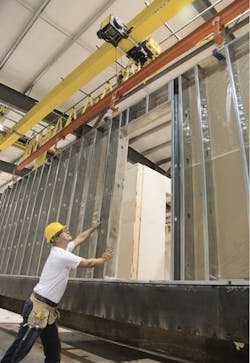3 Reasons Off-Site Construction Could Help Shape the Future of Housing
Off-site construction is an innovative approach to challenges that impact the home building industry, like disaster relief or costs attributed to material waste. And as a housing supply shortage continues to contribute to an overall housing affordability crisis, the opportunity to expedite the home-building process through off-site construction, and the controlled environment in which systems-built homes or components are constructed, provides a potential solution.
“In this day and age, we’re faced with labor shortages and energy requirements,” Brian Sielaff, NAHB’s 2021 Building Systems Councils (BSC) chairman and CEO of Tamarack Grove Engineering, a structural engineering firm, shared on a recent episode of Dave Cooper Live, an online video series. “The Building Systems Councils and what it stands for – with the concrete industry, modular, panelized, log and timber – it’s on fire right now.”
All of these building systems offer benefits to builders who adopt them – including less on-site build time, less labor and waste and greater reliability because of the controlled factory environment in which the components are built.
Less On-Site Build Time
Because building system components are constructed in a factory, the standardized production process means they can be built more quickly. And after production in the factory, NAHB analysis shows it typically takes just two days to set a modular home on its permanent foundation.
Component-based systems, from prefabricated roof trusses to structural insulated panels (SIPs) and insulated concrete forms (ICFs), can also reduce build times.
“Many builders don’t recognize the speed of construction that these types of systems would have given them in their overall projects,” observed Dan Mitchell, president of Eagle CDI and 2017 BSC Builder of the Year. “Building systems would speed up their construction by 10-15% by having those components built in a factory as they handled components on site, such as land development, driveways and foundation. Once those site conditions are prepped and ready, the components could be shipped to site and put together in a quick format.”
Greater Reliability
Delays in construction are common and can be costly. Off-site construction helps alleviate many of these issues because the controlled manufacturing environment of systems-built construction enables builders to establish a more predictable and consistent production schedule.
“Systems-built homes and products are mostly produced in controlled environments and are not subject to weather issues,” stated Michael Weber, national business development manager for The Euclid Chemical Company and past BSC chairman. “The manufacturing process provides accurate measurements and construction practices under the most stringent tolerances.”
Because of these standardized manufacturing practices, Weber added, these systems are built to the most stringent building codes – which “would typically be described as ‘code plus’ construction, exceeding the minimum building requirements” – to meet all regulations within the manufacturing plant’s shipping radius.
Less Labor and Material Waste
Some prefabricated systems, such as steel components, structural insulated panels and concrete forms, cut down on labor and material waste while also providing alternatives to lumber-based building.
Off-site construction projects are part of a system, which means they are designed to be precise. As such, the process to put together these components is straightforward and efficient, and leaves little room for wasteful assembly.
“If you’re doing off-site, you’re in a controlled environment working off-site,” Brittanie Campbell-Turner, founder and CEO at Constructrr, explained during a recent episode of Dave Cooper Live. “You reduce the amount of safety concerns as a result, because you have people working in a safe environment. You reduce the amount of travel that you have to go back and forth. That’s less time on the road. And then the amount of material waste – you reduce that considerably because you don’t produce any.”
Workers on-site are able to quickly assemble these components because the bulk of the work has already been completed in the factory or off-site production environment, reducing the number of laborers, and labor time, needed.
What Builders Need to Know About Off-Site Construction
With all of these benefits, why aren’t more builders constructing homes using off-site construction? To start, off-site construction isn’t just switching products – it’s switching operations.
“Off-site construction is not so much a physical product as it is a process,” said Gerry McCaughey, CEO of Entekra and 2019 BSC Manufacturer of the Year. “80% of what we do in our business is about process improvement, and 20% is about a hard physical product that you see up on the site.”
Because of this shift, there can be a learning curve to building homes using off-site construction.
“It takes at least two to three, or even four, homes to work out the kinks and the little nuances in the home-building process before builders become proficient with building systems,” Mitchell noted. “Once they do get the systems in place, they become extremely efficient and are able to schedule much more effectively.”
“One thing we’re really focusing on in 2021 is being a hub for builders who want to learn more about systems-built and off-site construction,” said Devin Perry, NAHB Executive Director for Business Improvement Programs. Visit nahb.org/whybsc to learn more about building systems and NAHB’s Building Systems Councils.


